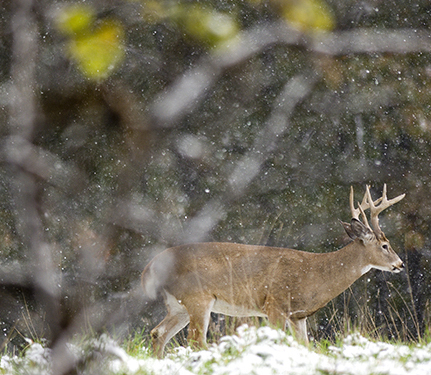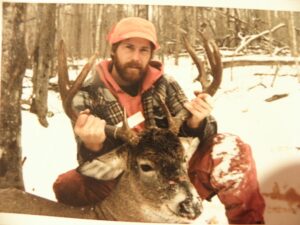Michigan’s UP Deer Numbers Continue Downward
By Glen Wunderlich
Charter Member Professional Outdoor Media Association (POMA)
During the 1980s in Utica, Michigan, I became good friends with a man known as “Big John” Stenvig. When the ‘ol Finlander retired, he moved closer to his Yooper roots in Baraga, Michigan in a small house overlooking the Keweenaw Bay. In 1986 Big John invited a close friend, Fast Frank, and me to hunt deer in the vast Upper Peninsula reaches of Iron County.

Big John Stenvig, Big Allice and Fast Frank (facing away)
Little did we know that the deer hunting was about as good as it was going to get. We never saw many deer, but because we saw even less hunters, the serene experience suited our hunting style nonetheless. We took some good bucks over the years – one of which is listed on the pages of Michigan’s Commemorative Bucks record book – and made the commercial forests of the U.P. hunting headquarters for the subsequent decade.
Deer numbers were in obvious decline, as evidenced by my only sighting of a whitetail after three days of hard hunting during our last trip to the land of Yoopers.
Buck harvest (a reliable barometer of deer numbers) was at an all-time high from the late 1980s to the mid-1990s and winters were noticeably milder during this time period. The consecutive severe winters beginning 1996 and 1997 have resulted in periodic declines in buck harvest since then. In fact, in the last 11 years, there have been six severe winters that have impacted buck harvest, further restricting the growth of the U.P.’s deer herd.
The most recent wolf population survey conducted in 2022 sheds light on a study by Kristie Sitar and Brian Roell: Factors Limiting Deer Abundance in the Upper Peninsula. The minimum wolf population estimate from the 2022 survey is 631 wolves, plus or minus 49 wolves. A total of 136 packs was estimated with an average number of individuals per pack calculated at 4.5.
However, wolf density appears to have shifted over time.
“The density of wolves may have decreased in some areas of the west U.P. and increased in some parts of the east U.P.,” DNR wildlife biologist Brian Roell said.
In the Upper Peninsula, coyotes kill more fawns than any other predator, followed by black bears, bobcats, and wolves. Other non-predatory types of mortality, including malnutrition, disease, abandonment, vehicle-collisions, etc. have a greater impact than predation from any specific predator in the Upper Peninsula.
Gray wolves are currently on the federal list of threatened and endangered species. Consequently, they cannot be killed legally, unless in defense of human life. Regardless of changes in legal status, wolves in Michigan have surpassed federal and state population recovery goals for 22 years.
The abundance of each predator is important in determining how many fawns are killed across the landscape. In the Upper Peninsula, each coyote kills about 1.5 fawns per year, on average. However, coyotes are so numerous that the overall impact from coyotes is the greatest for all predators. Black bears are also effective predators on fawns, killing 1.4 fawns per bear each year. Bears are also abundant, and therefore, have a large impact on fawn mortality. Bobcat and wolf populations are much lower, so even though they kill more fawns per year (6.6 per year for each bobcat and 5.6 per year for each wolf), their overall impact on fawn mortality is reduced. The math indicates that wolves, therefore, kill over 3,500 deer per year in the U.P.
In the Upper Peninsula, occasionally very severe winters with deep snow lasting 100 days or more are substantial enough to cause high adult doe mortality due to malnutrition. In those years, adult doe survival is the most important factor driving deer population growth until the population rebounds. The question of any resurgence in the Upper Peninsula deer population is “if” it will ever rebound, rather than “when”.







You missed key findings of the study you mentioned (Factors Limiting Deer Abundance in the Upper Peninsula) Nearly 70% of the wolf predations of adult does occurred in the late winter and spring months when body condition of deer was at its poorest. ? Further investigation into the body condition of adult does killed by wolves in the high snowfall zone found that
nearly half (43%) were in extremely poor nutritional condition and likely would not have survived the winter even if they
were not preyed upon. In other words, the deer were literally walking dead. Further, weather, habitat, forestry practices each have a greater impact on deer survival than predators alone
https://www.michigan.gov/dnr/-/media/Project/Websites/dnr/Documents/Boards/WMAC/WMAC-Various-Docs/factors-limiting-deer-abundace-in-u-p.pdf?rev=d0c08c788ca540ee8ec1e3981d4ca014&hash=4E98DCA43AD4D839CCDF7BC53E6848BB
Glen,
John Ozaga is fond of quoting an Eglish agrarian’s statement: The head grows according to the pasture.” You mention a variety of mortality impacts that remove deer from the UP’s landscape, but, other than a general nod to winter severity, you do not opt to focus at all on the top limiting factor that impacts deer survival, as well as herd growth– winter habitat condition,site abundance across the landscape of the peninsula, and status. Over seven years ago, the UP Habitat Work Group was formed as an initiative that melded professional foresters from State, Federal, private corporate, and private lands management entities together into an interactive sequential exchange that enabled updated functionality estimates, location mapping, updated functionality and condition estimates, use patterns, etc, that lead to development of site specific plans for each Winder Deer Complex within the UP, as well as management plans for these “Green Barns” to stabilize them and potentially grow their acreage. Since these form the pinch-point for the whitetail herd numbers to be carried through a normal winter with minimal mortality, this point is noteworthy, Since much of the evidence from multiple studies indicate that those Michigan deer wolves prey on are largely energy store depleted animals that result from winter length and severity induced starvation, their importance (WDCs) is further underscored.
I used to own a hunting cabin on 326 acres located north of the Sturgeon River gorge. I sold it 1.4 years after the two disastrous winters that occurred back-to-back in the mid-1990s after a lengthy conversation with John Ozoga.